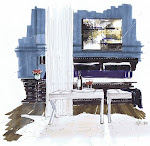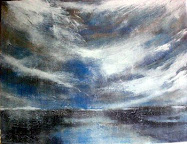

While we finish up the first video, I thought it would be fun to get limbered up doing a practice rendering…I’ll call these drawings the “Colouring Book”. Print out the first drawing (doesn’t have to be more than 5x7), tape a piece of trace or rag paper on top, use a fine liner (.05 or .03) to sketch the drawing, apply gray shadows, then colour, darker shadows, finish with fine liner texture and remember some lighting effects. You can use mine for reference if you like, but try using your own colours and design elements like the nail heads, art, rug, etc. This will be our first drawing, so give it a go, keep it as your “before” and date it, because it’s rewarding to look at your progress. I’d love to see some of them, so please…email me your finished rendering! (I would never post them without permission)



Colouring Book (Blue Bedroom)
Original art, Interior Design and Rendering by Michelle Morelan Design, 2010
<<<<<<<<<<<<< . >>>>>>>>>>>>>>
Materials List:
You can order these online, but a visit to the art store is great to get the juices flowing; go to a type which has a large selection of canvases, as it will most likely have these supplies; not Michaels…they only carry Prismacolour markers.


-
Light table set up (glass and lamp will do). If you don’t have piece of glass, consider the “as is” bin at Ikea for a glass door or small table top for one of their cheap end tables; just make sure it’s big enough to hold a legal size paper, with some space around. Always use tempered glass with a finished edge!
-
Paper: both plain paper and archival rag paper. Use larger than letter size if you can, but you are limited to the size of your scanner- You can work as small or large as you like. I have a scanner that scans up to ledger size (11x17), so I use larger paper. I use Bienfang Graphics 360- 100% rag translucent marker paper (this is like tracing paper, but it doesn’t bleed, is thicker and is able to handle the marker manipulation). Just ask the clerk for marker paper- archival.
-
Drafting tape; it’s less sticky than regular masking tape, but that will do too…just put it on your pants or skin first to get most of the stickiness off.
-
Black fine liner pens: Copic Multiliner SP .03, and .05, Staedtler pigment liner .1 (an assorted pack of thicknesses is a better deal)
-
Artist pen by Faber-Castell in the B thickness; this is a paint brush type tip- a multipack of greys and a multipack of colour is a better deal, 199 (dark gray), 272 (light gray),174 (green), and 247 (blue) are some I use often. A thicker 180 (raw umber) is also useful.
-
Graphic pen 3000 duo tip by Staedtler Mars in 55 (green). These are some of my favourite paint pens, because they pool.
-
Tombo ABt paint pen 491 (glass coloured blue); its duo tipped
-
Copic Markers in W5 (Warm Gray #5), E49 (Dark Brown), 110 (Special Black), E43 (Dull Ivory)
-
Touch Markers CG5 (Cool Gray)
-
Prismacolour 96 (Blondwood)
-
Letraset Tria Marker in 120T (Medium Yellow)
-
primary red, primary yellow markers in any brand listed (if you are on a budget, use a red pen and a highlighter here instead).
-
Gold and silver roller ball gel type pens
-
A dual tipped black Sharpie
-
Signo pigment ink pen in UM-153 White
-
white artist chalk (the powdery stick type)
A tip on markers…a good range of grays (warms and cools) and an architectural pack is a great way to start your collection. Purchase what you think you need and use in your designs…like red, yellow (fireplace flames), greens and browns for landscape and colours of wood furniture. Don’t go to crazy buying vibrant colours at first, as they are used sparingly.
Investment in initial materials? About $200 gets you a nice supply. Markers are about 5 bucks each.


































